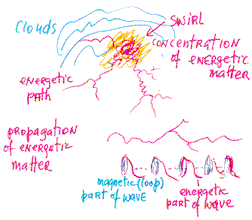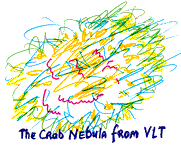The Speed
of Light
(The Propagation of Energetic
Matter)
Back to main Speed of Light Page
| After the Big Bang, energetic matter (see Wave Theory) has had only one objective: to return to its previous space. Energetic matter swirls and spins about (picture 1), creating wave formations with concentrated energetic swirls, which are the precursors of the galaxies and all other formations (Picture 2). |
|
 Picture 2 |
Astronomical observations and research
has provided us with pictures of ancient universes (over billions
of years old) in which we can identify the existence of swirl formations
(Picture 3).Experiments and computer models conducted at the Lawrence
Livermore National Laboratory simulated astrophysical phenomena such
as exploding stars. Pictures form this study illustrate the propagation
of energetic matter (Picture 4).
|
Moreover, pictures taken by the Hubble spacecraft (see the letter we sent to NASA) also reveal that the universe disseminates by virtue of the creation of swirling pillar formations (Picture 5). From other pictures, we also saw that energy spreads out (Picture 6a, b & c). |
|
 Picture 6a |
 Picture 6b |
|
In fact, the propagation of energetic matter is formed by serpentine movements of energetic matter that spin and swirl to create two loops: one energetic and another magnetic (Picture 7). This process is simple, yet extremely sophisticated.

Picture 7
Interestingly, in light streams (photons), energetic streams flow in opposite directions (Picture 8). This explains different light phenomena, including the Levandosky-Rosen-Einstein paradox. From energetic propagation, we see that different forms of wave streams (directions) may exist. This explains the energetic circulation between the waves that give the universe the same energetic levels and its stable rigid wave formation.

Picture 8
| Calculations and astronomic observations indicate that the distance between energetic formations are constantly expanding, but we have also observed the appearance of new galaxies (in the form of a wave composed of two loops) that were not formed by the collision of other galaxies. (Picture 9) This means that the universe resembles vibrant formations and will continue to expand until the energetic matter returns to its previous space. |
|
Nonetheless, there is no empty space per se in the infinite universe. Consequently, the matter and energy from the old universe will appear as new formations and perhaps as new universes.
We know from Einstein’s theory of relativity that a rocket that has more energy (speed) can travel a greater distance in a given period of time than one of lesser energetic capacity. The same principle thus applies to larger waves that contain more energy and are thus also capable of traveling greater distances over a given period of time. Signals, however, are transmitted instantly in waves at the same velocity regardless of their size, even if they reach epic proportions. Without the maintenance of these identical speeds the waves would disintegrate (Picture 10).

Picture 10
The universe’s massive waves travel at speeds that are difficult to comprehend. (Picture 11) Einstein predicted the existence of wormholes or similar matter that move at extraordinarily high speeds, despite the fact that he considered the speed of light to be the basis of his theory.

Picture 11
When I observe a lightening storm, it reminds me of the propagation of energetic matter. In fact, it is the same energetic behavior. The speed of lightening must differ from the propagation of light because its size is different (the difference is quite small, but this is how it must be). (Picture 12) These minute changes in the speed of lightening are left to be studied by experimental physicists.

Picture 12
In my work on the speed of photons, I point out that -- in addition to the Doppler phenomenon -- photons lose energy as do every other energetic formation. During this process, the photons shift to red. In fact, according to wave theory there is nothing permanent in nature and due to the loss of energy everything is subject to change, which can occur in various ways. Photons also disintegrate -- albeit at a slow rate -- due to its ideal balance between energetic and magnetic forces.
John Webb, Victor Flambaum, Michael Murphy et al, of the University of New South Wales discovered the deviant of the a constant. This discovery is valid, but does not necessarily refute Einstein’s ideas. According to wave theory, light streams have various energetic photons, and the links with other photons within the stream require continuous energetic activities. Photons constantly give and take energy to and from other photons, but the stream itself, which contains all these photons, maintains its average energetic level. While these similar formations behave in a similar fashion, they are not the product of a matrix, and every photon and wave has its own unique character.
Back to Top
The universe cannot propagate according to some mathematical constant
for it is an ever-changing formation. Furthermore, all waves are composed
of smaller components with different energetic properties and patterns
of behavior. Consequently, they have their own energetic properties. In
every energetic formation, energetic matter circulates in an energetic
path (quarks) and the matter circulates as vibrating packages, which send
and receive energetic signals. There can be no constant. Nonetheless,
the average propagation rate of energetic matter is more or less similar
to some constants over time with regard to waves of identical size. However,
since this is all part of one great wave that we call the universe, they
are in contact with other formations, and they transfer energy with their
neighbors as in any other stream. The incredible universe instantly transmits
the occurrence of every change in its energetic formations to the entire
universe by an array of bilateral energetic properties. This is accomplished
through rigid energetic matter, which is referred to as dark matter.
At this stage, I want to explain the phenomena of polarity, which was
incorporated as a a constant. The wave is made up of two loops: one energetic
loop and the second magnetic. However, the two loops are formed from one
continuous energetic stream (see wave theory for a step-by-step description)
in which the energetic loop is in horizontal position and the magnetic
loop is perpendicular. Changes to the energetic matter’s flow in
one stream affects the behavior of the both loops’ polarity. (Again,
see picture 6) As in the computer, the energetic loop’s stream is
referred to as + while the magnetic loop is denoted as 0 (-). The flow
of energetic matter in all formations always transpires in the form of
energetic activity, and it is thus constantly exposed to change. This
marvelous behavior is still difficult to comprehend, but nature and all
experiments, including quantum mechanics, provide clear examples of this.
Light streams are composed of billions of photons, and each one (like
living organisms) has its own unique behavior patterns.
Nevertheless, on average they provide similar results because in light
stream energy flows to all directions, and the photons are interchangeable.
These energetic formations behave in the same manner in every phase, but
their structure depends on the energetic loop (phase) in which the amount
of energetic matter that circles around the wave formation is different
in every phase.
Wave theory, like Darwin’s theory, is a natural theory, but it
integrates most of the laws of quantum mechanics and Einstein’s
sophisticated ideas. In contrast to other theories, wave theory is open to change and can consequently be adapted
in a logical manner to conform to important breakthroughs. Two loops in
one wave -- this is the building block of nature! Everything works on
this principle (Picture 13).
theories, wave theory is open to change and can consequently be adapted
in a logical manner to conform to important breakthroughs. Two loops in
one wave -- this is the building block of nature! Everything works on
this principle (Picture 13).
Picture 13
With this in mind, it is very useful to take note of the following simple equation:
E/M = Phase
E = energetic matter (loop) M = magnetic matter.
Wave theory is only the beginning of another
way to understand the universe. This decade has provided a bountiful harvest
of breakthroughs in the field of physicists. Webb, Flaumbaum, and Murphy’s
observation has come along at just the right moment as it affirms the
legitimacy of wave theory. Correspondingly, wave theory explains their
discovery.
Einstein based his theory on light streams’ constant on the average
number of photons in a light stream, which fit his particular era. Wave
theory, however, expands on this idea -- just as Einstein provided a continuation
of Newton’s theory without detracting from it significance. Wave
theory, which like Darwin’s theory is based primarily on the natural
sciences, shows that everything is subject to change.
These and other breakthroughs (most notably Max Planck and other works
on quantum mechanics) herald a new era, which is built on the foundations
of the ingenuous theories of the nineteenth and twentieth century. Wave
theory tries to tie the vast array of ideas together by explaining wave
formation and energetic matter -- in essence everything -- as the product
of two loops in one wave. This eclectic approach fuses and rests on the
past in order to push us on to the next level.
- end -




